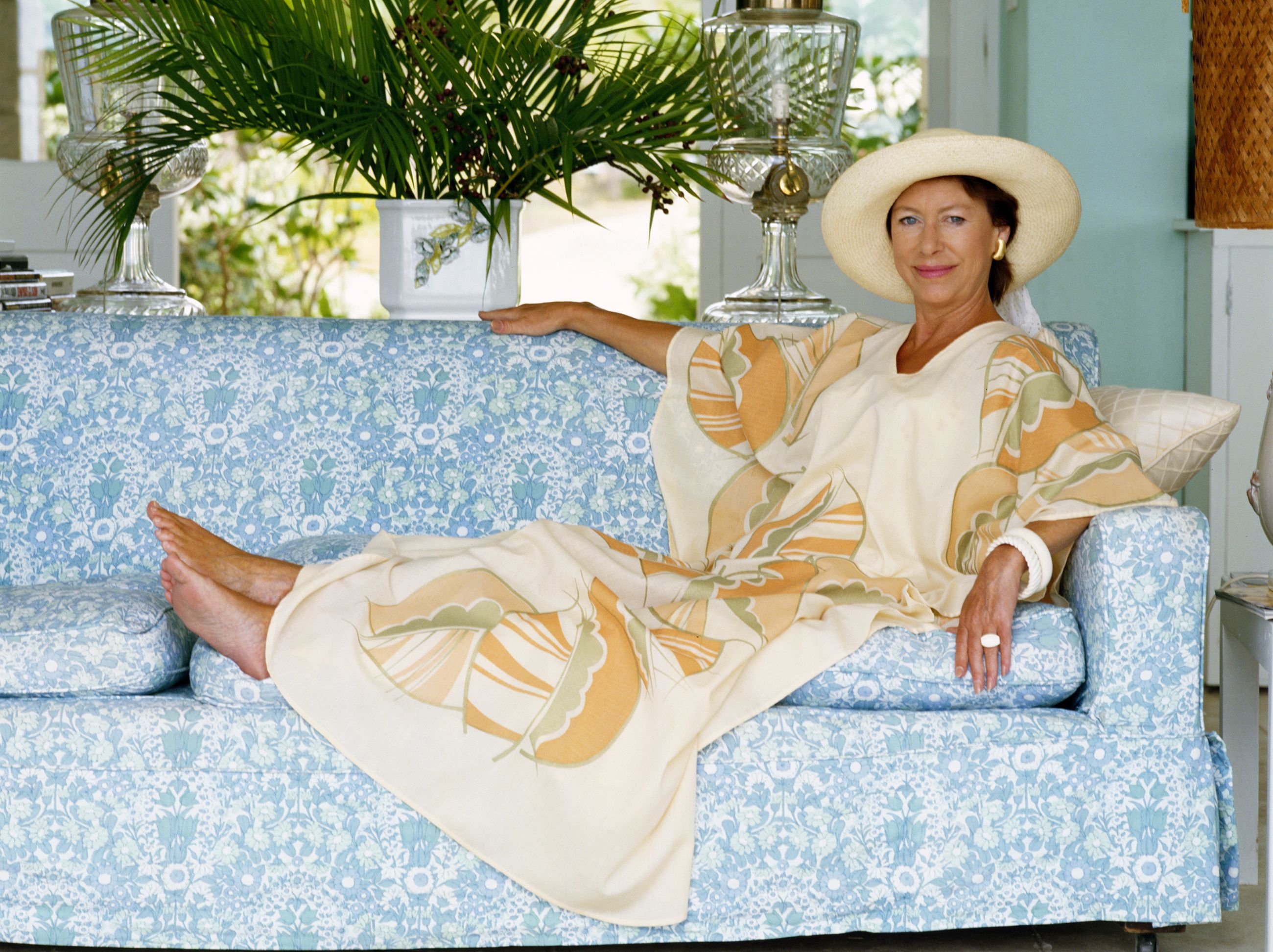
Princess Margaret's Love Affair with the Island of Mustique
If you didn’t have the right whiskey, forget it—Princess Margaret wouldn’t be spending long at your party. Tatiana Copeland laughs as she recalls hosting Margaret in Mustique in that gauzy heyday when the Caribbean island, part of St. Vincent and the Grenadines, held the reputation for being a hedonistic idyll—of the very exclusive, fabulously wealthy kind. Margaret’s preferred brand, allegedly the Famous Grouse, couldn’t be purchased on the island, which is just three miles long and one and a half miles wide. “You had to make sure you had it when she came to your house,” says Copland, an American who, together with her husband, has been going to Mustique since the 1980s. “If you didn’t have her whiskey then that was probably the last time she would go to you. If you couldn’t be bothered to know what she liked to drink, she probably wouldn’t be bothered to come back to you.”
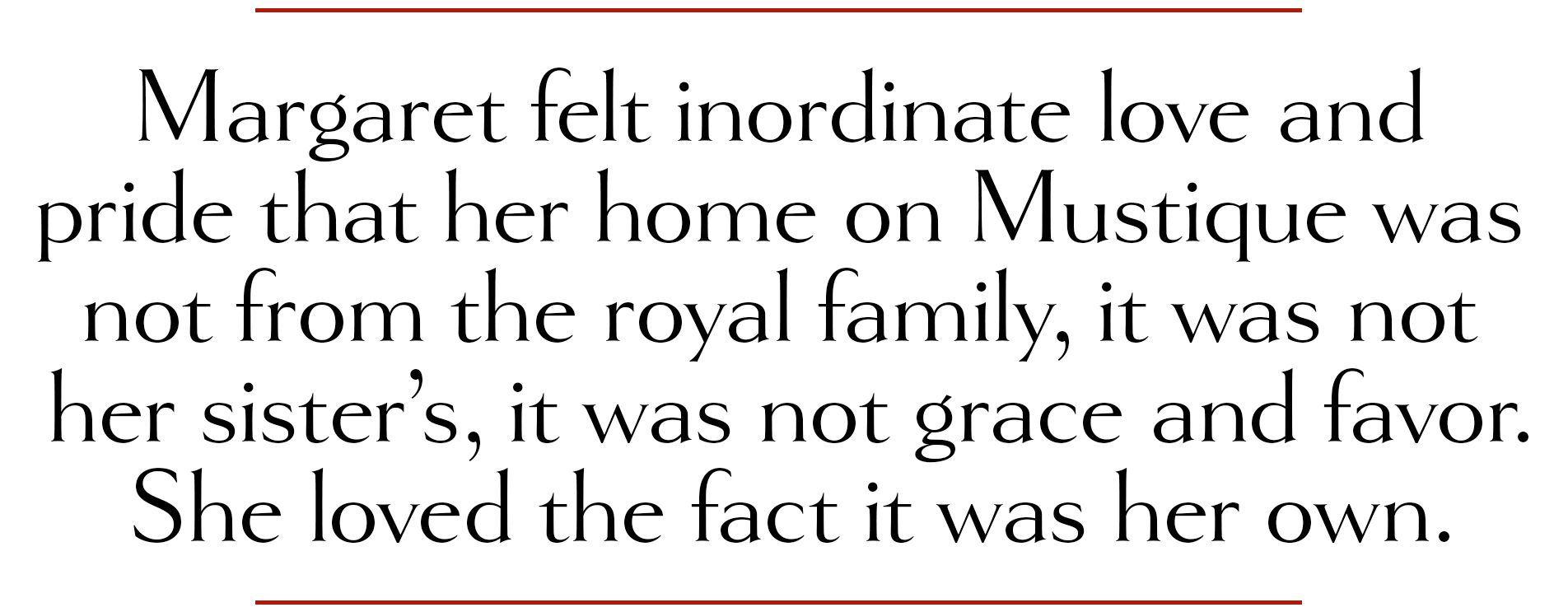
Copeland knows how it sounds. “Nobody sane comes to Mustique,” she tells Town & Country. “All the people who come are totally unusual, striking, and eccentric. I think that’s what attracts them to the island.”
The little island was mostly a secret until it became known to the wider world in 1976, when photographs taken there of Margaret and Roddy Llewellyn—the man with whom she had an eight-year affair beginning in 1973—were published by the British News of the World.

Anwar Hussein
At the time, Margaret was still married to photographer Antony Armstrong-Jones; Llewellyn was a landscape gardener 17 years Margaret’s junior, and the exposure of their affair led to Margaret’s split from Armstrong-Jones (known as Lord Snowdon) two years later. Margaret and Llewellyn did not end up together—in 1981, he married Tatiana Soskin—but they remained friends until Margaret’s death, aged 71, in 2002. (The affair and its fallout are portrayed in the third season of The Crown, starring Helena Bonham Carter as Margaret and Harry Treadaway as Llewellyn.)
Despite the scandal, Margaret adored Mustique until the end of her life, maintaining that it was “the only place I can relax.” Her home on the island, called Les Jolies Eaux, was built on 10 acres of land that had been a wedding gift from Colin Tennant. Tennant, who bought the island in 1958 for what would then have been around $120,000 and founded the Mustique Company, was married to Lady Anne Glenconner, Margaret's close friend and lady-in-waiting. It was Glenconner who introduced Margaret to Llewellyn.
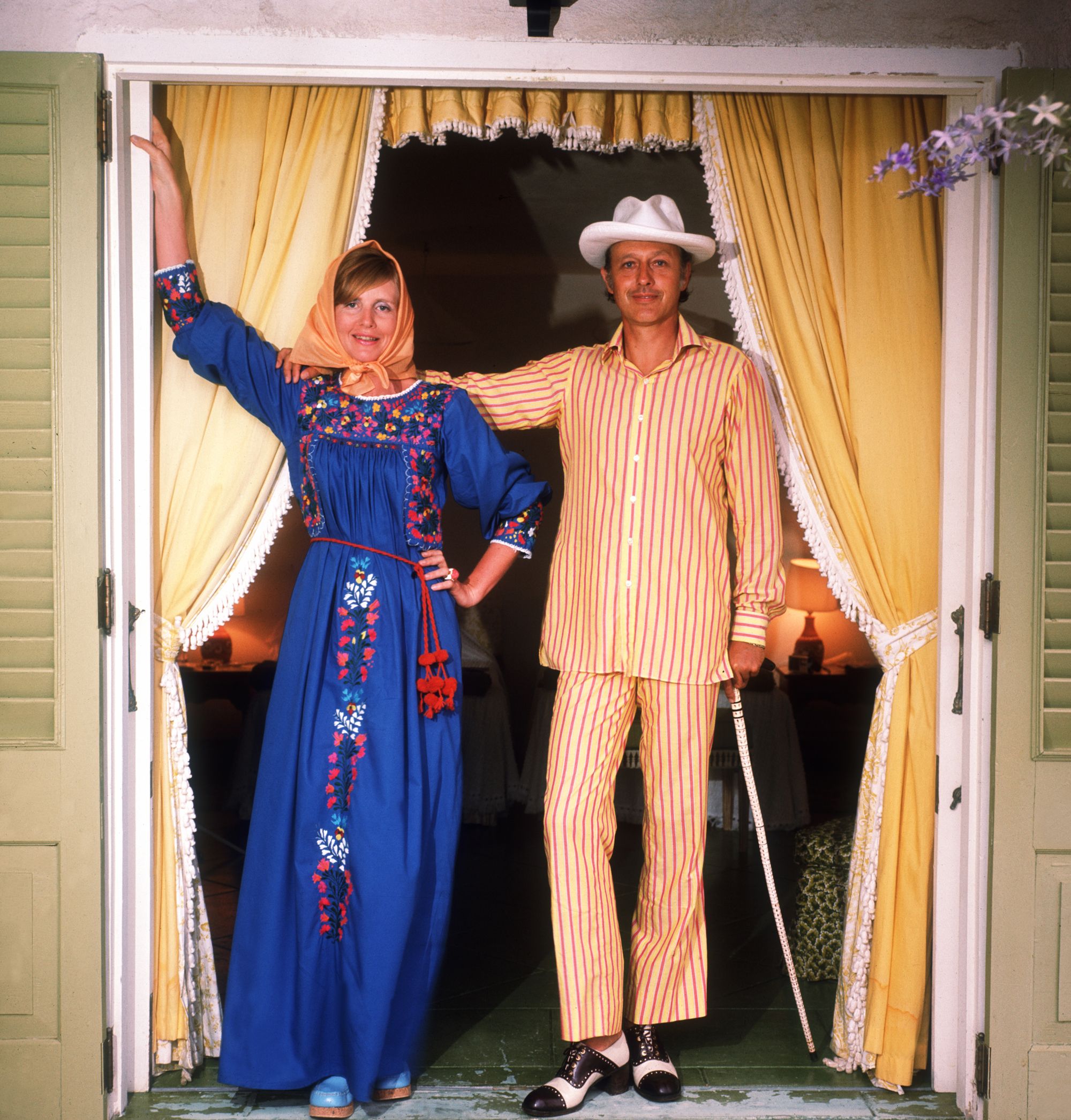
Slim Aarons
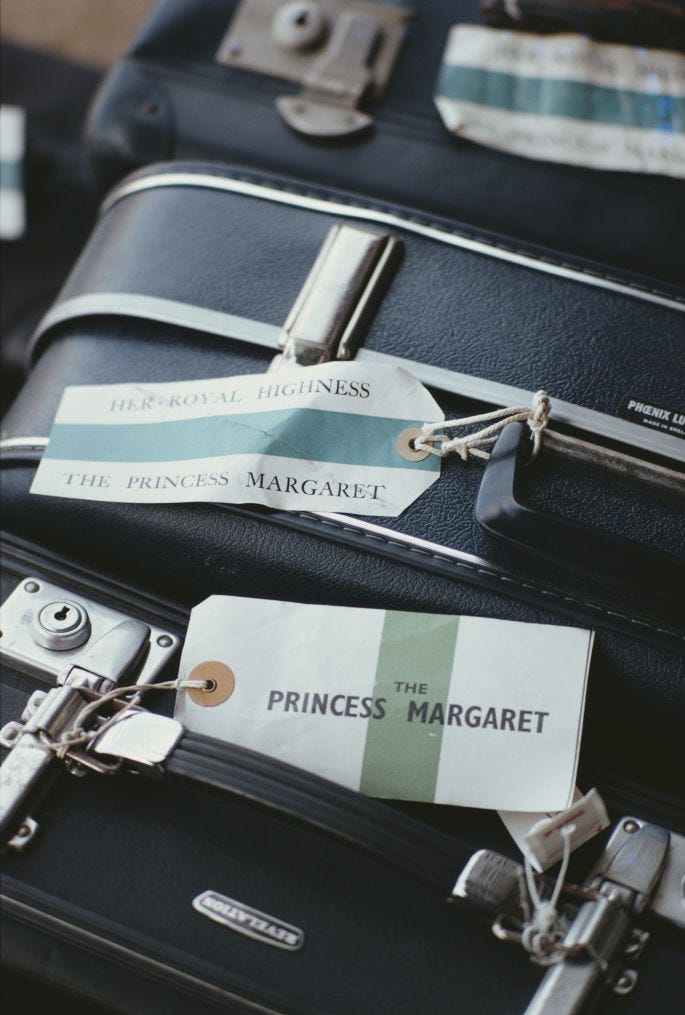
Slim AaronsGetty Images
Margaret went to Mustique twice a year, in October/November and February. “She loved the island,” says Copeland, whose husband, Gerret Copeland, is the son of Lammot du Pont Copeland, the 11th president of the DuPont Company. “Margaret told me Les Jolies Eaux was the only property she had ever owned in her entire life. It was hers. She felt inordinate love and pride that this was not from the royal family, it was not her sister’s, it was not grace and favor. She loved the fact it was her own.”
Basil Charles, former owner of the island’s famous Basil’s Bar, told T&C that Princess Margaret was “an amazing person, so beautiful. She was friendly, fun. She liked partying, late nights, and to dance.”
Brian Alexander, who managed the island from 1979 to 2008 and who remains so discreet he professes not to recall anecdotes, said Princess Margaret was a “really good friend to me and my wife, and to everyone here. I know it’s not how she is portrayed in newspaper clippings, but she was a really nice, kind, good person.”
He was on the island when the scandal around Margaret and Llewellyn broke, but says today the media “exaggerated certain aspects, which I understand—they have to sell product. But the real background to the whole thing was people having nice holidays on a tropical island.”

On Mustique, Copeland saw both Margaret the diva and Margaret the down-to-earth. “She could be very royal and very demanding, and very warm and friendly. You never knew which Princess Margaret would arrive,” says her friend. “She could be very entertaining and very funny. She could also be quite a handful. She liked to be courted and looked after. If she felt properly taken care of it was fun. She liked the company of good-looking men and preferred the company of men to women.”
The princess didn’t like anyone to be overly familiar, however. “She was a royal person. You had to know your boundaries: no hugging and kissing,” says Copeland. Upon meeting Margaret for the first time on Mustique, recalls Copeland, you addressed her as “Your Royal Highness”; after that, it was “ma’am.”
Not even on the beach were the rules forgotten. “If you were English, you curtsied on the beach in a bikini, which was a little strange. Americans didn’t have to do it.”
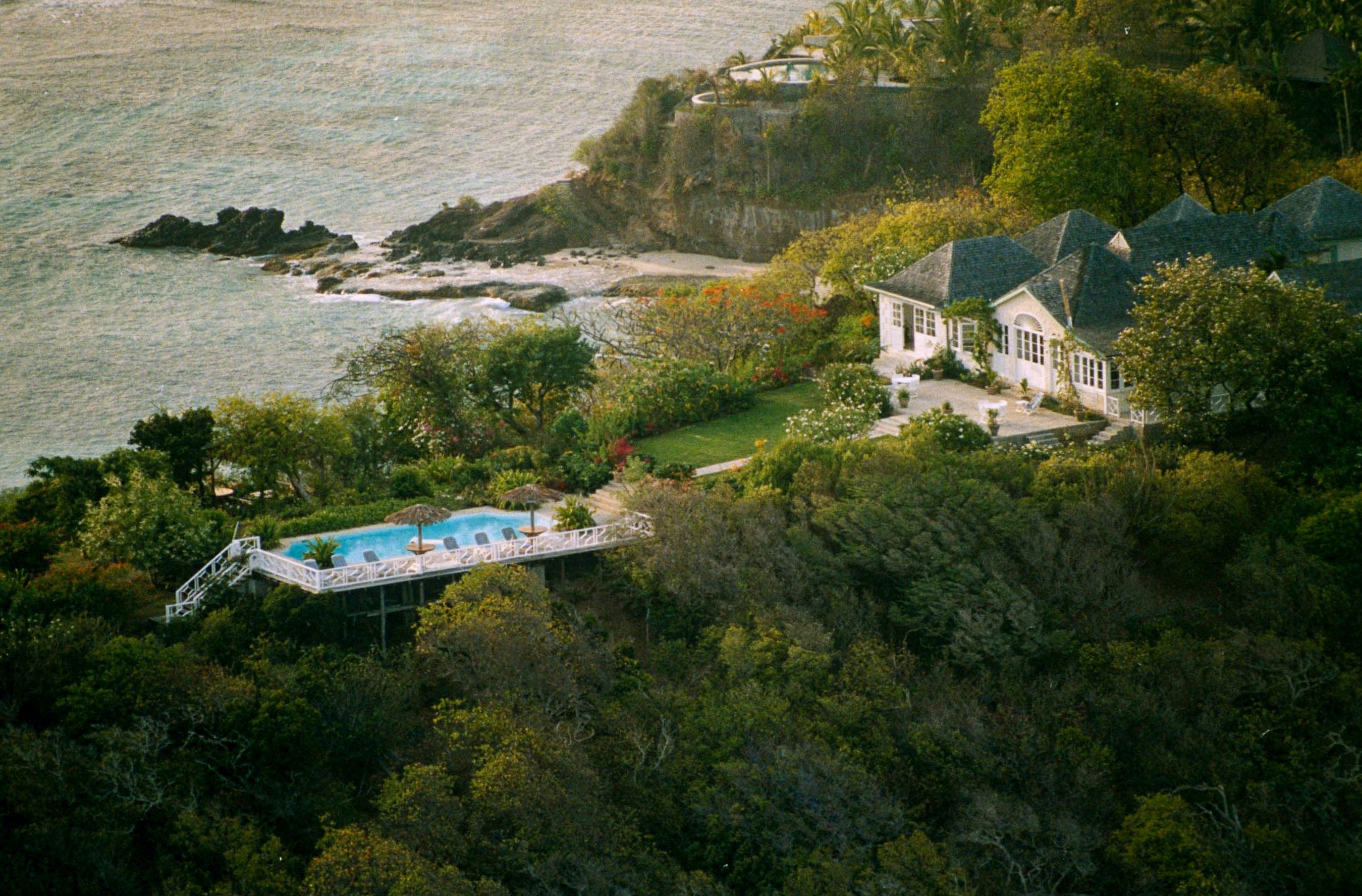
Leon Schadeberg/Shutterstock
Despite her insistence on protocol, Margaret was far from buttoned up. “It could be very wild and unrestrained,” says Copeland, who once rented Tennant’s Great House property on the condition that she and her husband host Princess Margaret personally. “She liked nothing more than to sit and drink and sing a ditty at the piano,” Copeland recalls. “She sang somewhat off-color songs sitting on the stool with a piano player. She had a very ribald sense of humor, which, around the right people, was pretty bad. She loved that sort of stuff.”
Anyone who spent time on the island in those years has memories of the merry Princess. Jeannette Cadet, who has lived on Mustique for 33 years—for most of that time as the Mustique Company’s villa rentals manager, and now its real estate manager—recalls Princess Margaret as “quite tiny and very fun-loving. Every day she would have lunch on the beach or at someone’s house. Like all Brits, she loved the drama of dressing up.”

Lichfield
Tennant and Glenconner formed the core of Margaret’s social life on the island. At his 50th birthday in 1976 Princess Margaret crowned Colin Tennant “King” of Mustique. “Colin was a master of creating something, and his whole job was to entertain Princess Margaret,” says Copeland. “He loved dressing up, and he had trunks full, literally trunks full, of costumes. So, you could be an Indian princess, you could be a pirate, you could be a mermaid, a wench. That was fun. When you dress up, you step into a different world and change your personality. I’m sure copious amounts of rum helped.”
It was painful, says Copeland, to see Margaret’s joie de vivre decline, alongside her physical mobility, at the end of her life. “Her speech became more impacted,” says Copeland. “I didn’t think she wanted people to see her like that. She wanted people to remember how she was.”
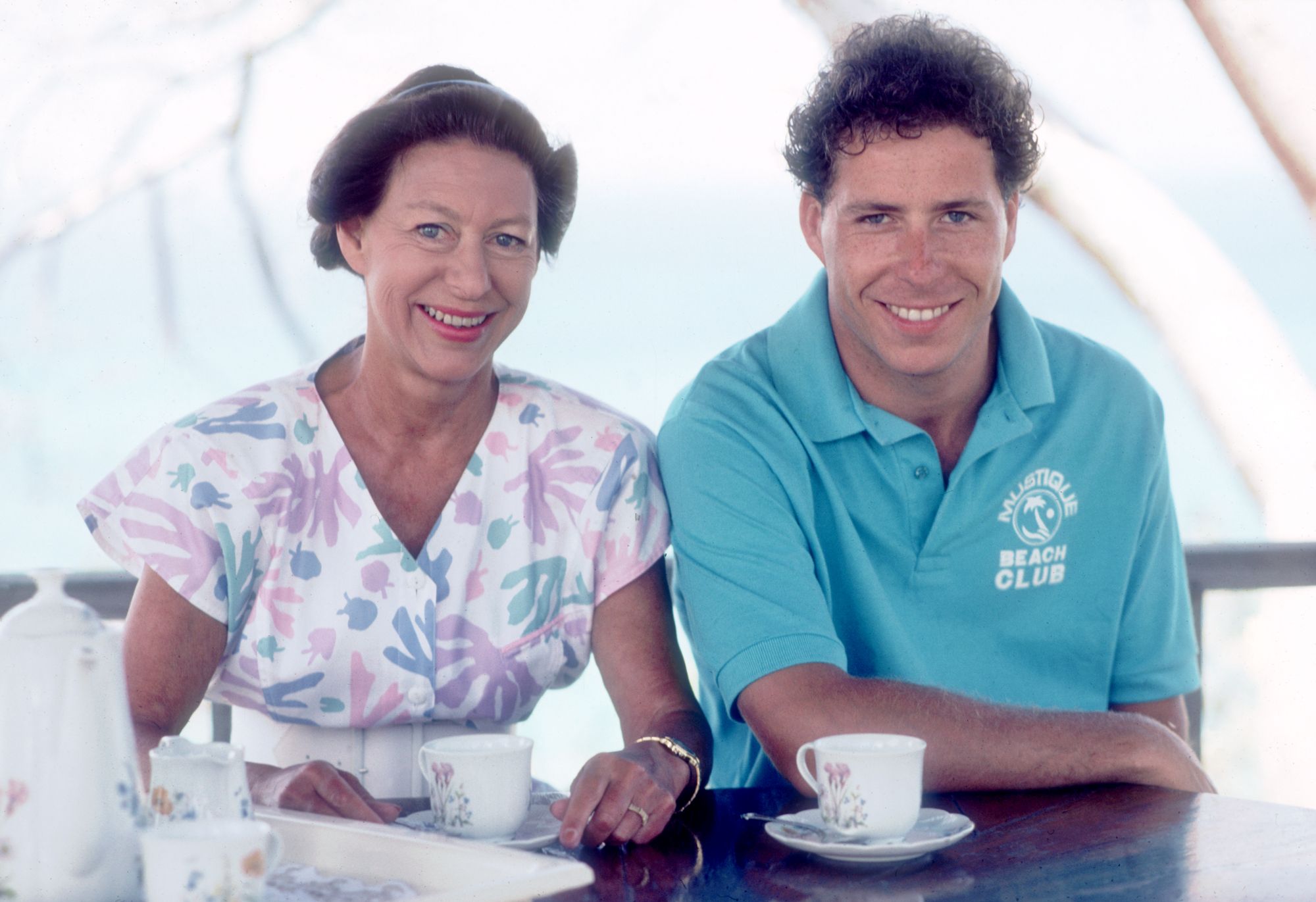
Slim Aarons
In 1996, a few years before she died, Margaret gifted Les Jolies Eaux to her son David Linley, who sold the property in 2001 to American businessman Jim Murray.
Two decades later, the island has lost some of its ramshackle glamour but remains an exclusive retreat. It’s home to about 100 properties and is now worth hundreds of millions of dollars in real estate alone. (You can rent the five-bedroom Les Jolies Eaux for between $21,000 a week in the off-season to $62,000 in high season; it comes with a staff of five, including a chef.)
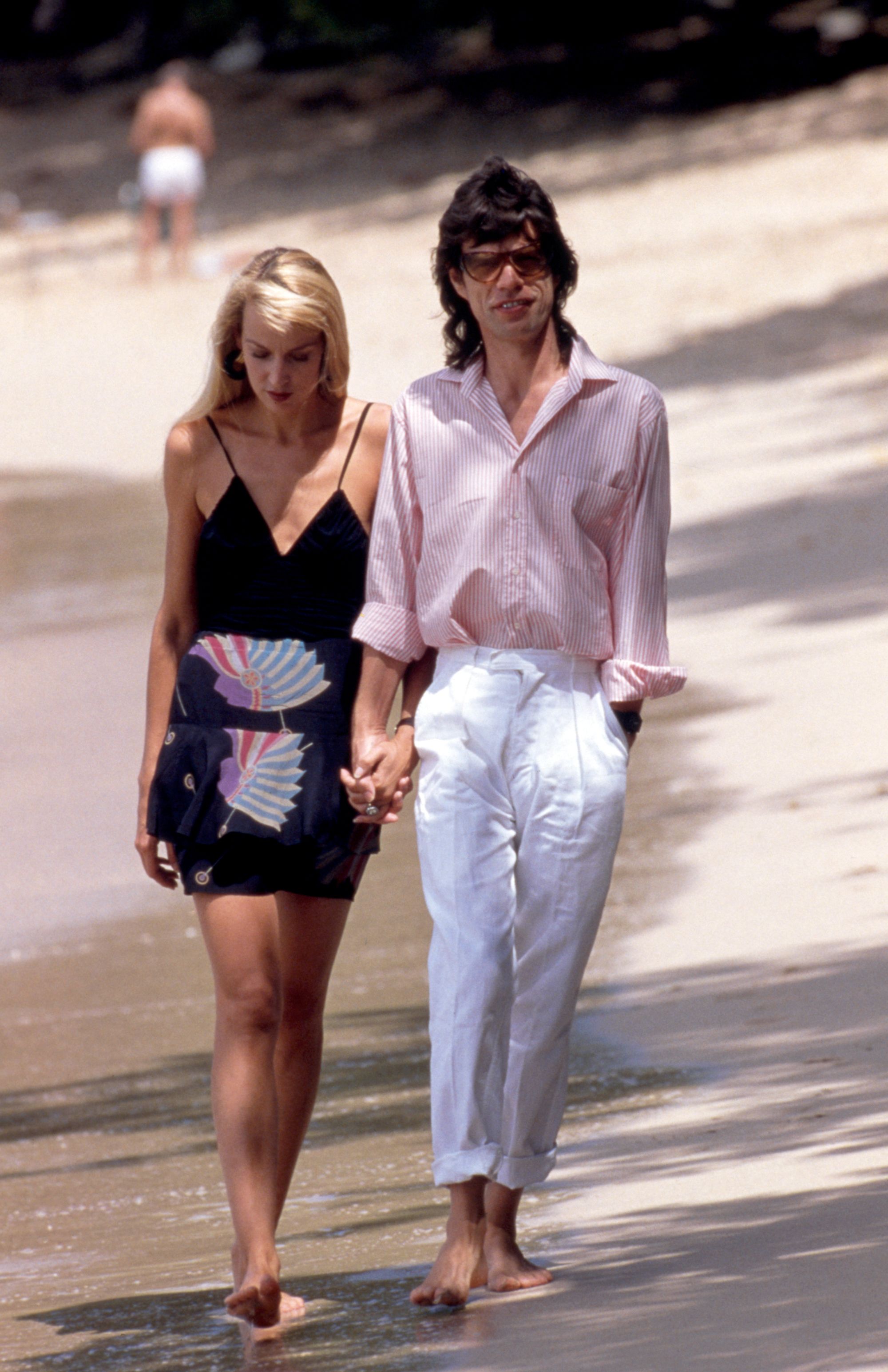
Georges De Keerle
Mick Jagger, Bryan Adams, and Tommy Hilfiger have homes there. Other famous visitors include Taylor Swift, Bill Gates, Victoria Beckham, Katy Perry, Orlando Bloom, and Daniel Craig. There is even a new generation of royals—Prince William and Kate Middleton and their family stayed at the island’s Villa Antilles this summer.
Mick Jagger “basically sticks to himself,” says Jeannette Cadet. “I see him around all the time; it’s no big deal. I just had lunch with Bryan Adams. Shania Twain was here at one stage. And David Bowie was close to my heart: he was so into the community. Every Tuesday evening he would read stories to the schoolchildren.”
Privacy remains Mustique’s most exclusive asset. (No one was disturbed to film The Crown, for which locations in southern Spain substitute for the beaches and tropical lushness of Mustique.) “That is an extraordinary luxury in this world,” Copeland notes. “If Prince William and Kate and the kids want to go to the beach, they are left alone.”
Still, the island isn’t what it once was. Copeland said that when she and her husband first went to Mustique in the early 1980s, there were just a few cars (most people got around using golf buggy-style vehicles called Mules), no golfing or museums, only a few shops, and dinners overlooking the sea and stars. It was a time of “far fewer houses, far fewer people, far fewer everything,” says Cadet.
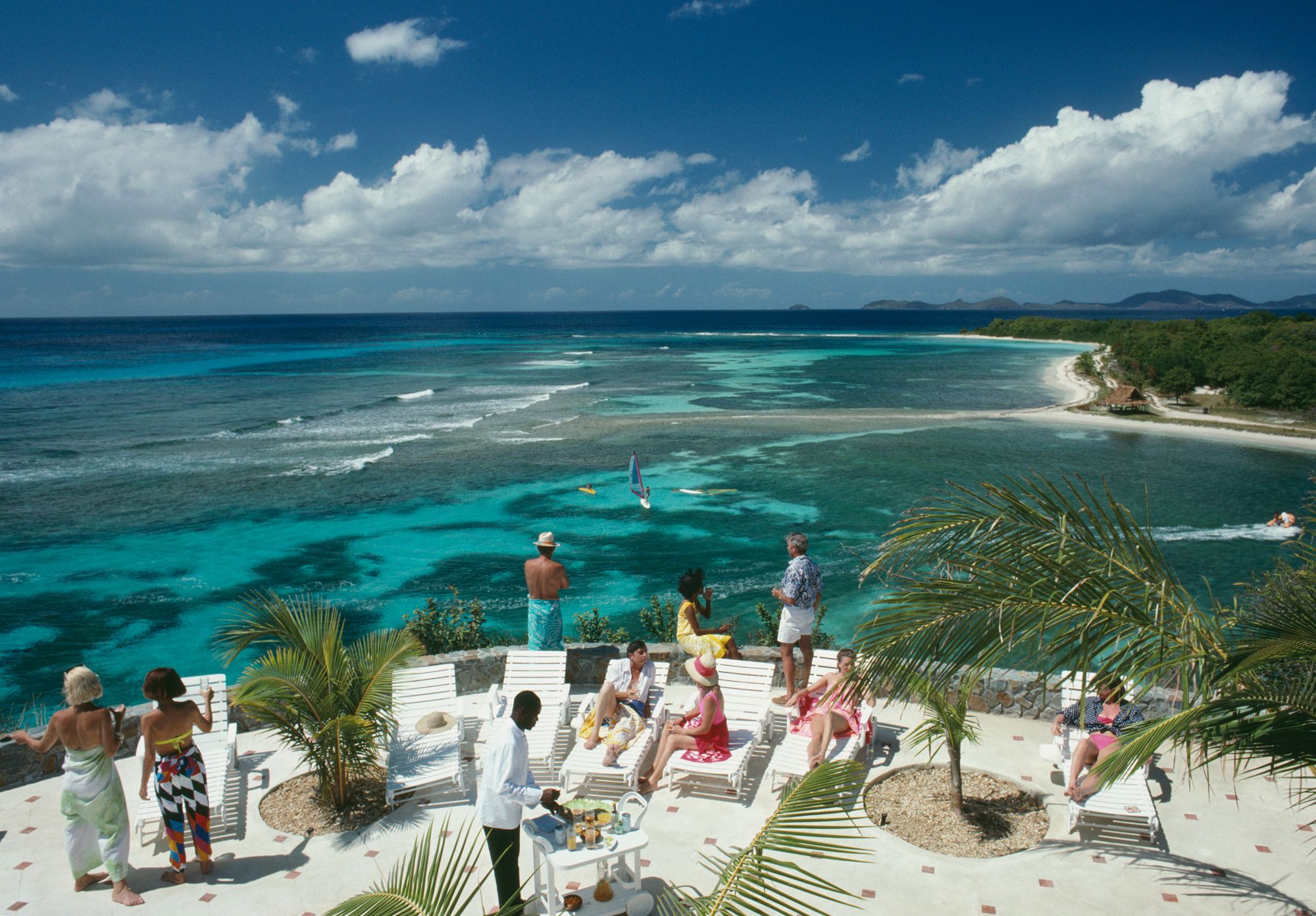
Slim Aarons
“Old” Mustique was based on the social principle of invite others to your house and be invited to other people’s houses for drinks and dinners. In the old days, nobody sent invitations, says Cadet. “The news got around of house parties, but now that the island holds around 1,200 residents, with 600 to 700 guests on top of that, it’s not possible for everyone to gather in the same way.”
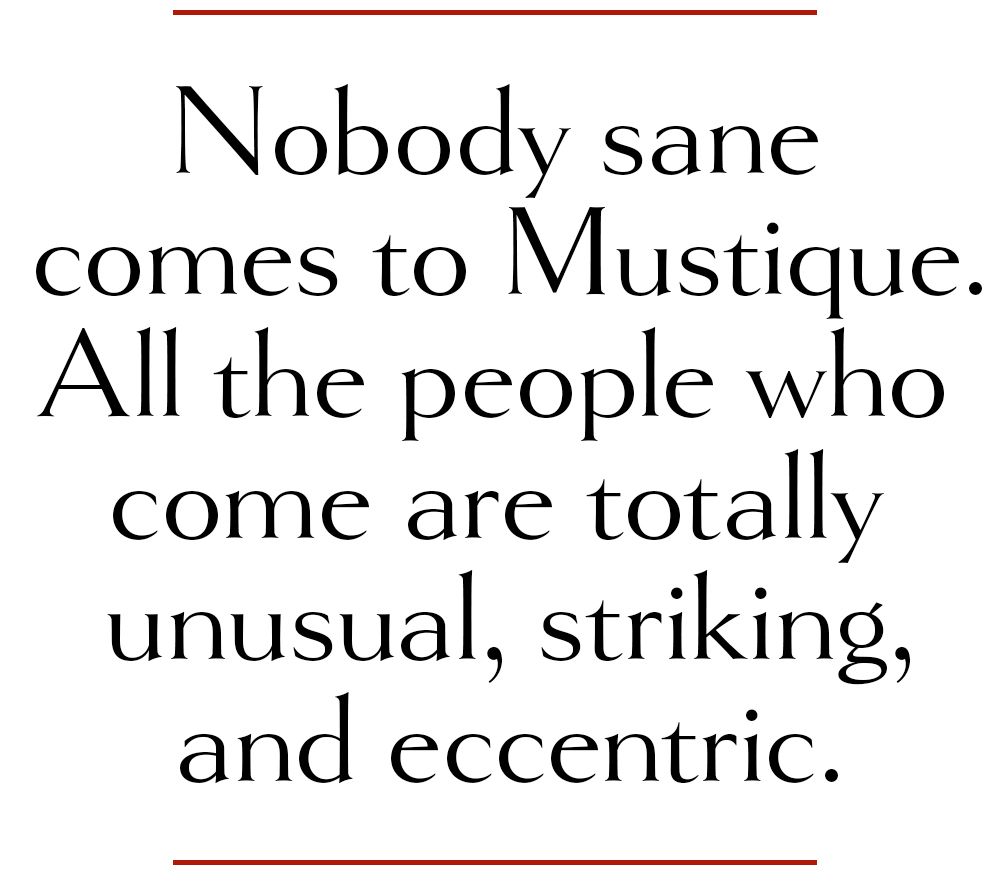
In the late 1970s, financial problems led Tennant to sell his majority stake in the Mustique Company for around $1.8 million to a consortium headed by the Venezuelan paint manufacturer (and Mustique homeowner) Hans Neumann. In Joseph Bullmer’s revealing 2000 documentary, The Man Who Bought Mustique, society photographer Lord Lichfield said that artists like Tennant were not best suited to financial matters and that his vision for Mustique had been “hijacked by the men in suits.”
Tennant still took pleasure from visiting Mustique, but found the board of the Mustique Company to be full of “smug, inept, incompetent” people, or so he said in The Man Who Built Mustique. Tennant’s eccentricity, wit, and quick temper are much in evidence in the documentary. The filmmakers followed him as he returned to the island to erect an ornate tent to host a lunch with his old friend Princess Margaret, bossing and berating people in the process.
Roger Pritchard, the present managing director of the Mustique Company, told T&C that the island has indeed changed since Margaret (and Tennant’s) time. “It’s more family-friendly. When Princess Margaret came, she partied hard. Modern celebrities and royals come not to get away and party, but to have a good time. It’s family entertainment they want more than hedonistic entertainment.”

Courtesy Toucan Hill
People ask Copeland whether she prefers the “old” or “new” Mustique. She tells them that she likes the best of both worlds. If, in the old days, electricity and water were patchy, and “you would gather down at the harbor to buy food from the ship when it came in.” Island life then was “democratic in a sense,” says Copeland. “A duchess could dance with the fishermen at Basil’s. I’m not sure that would happen today.”
Copeland still hosts parties at Toucan Hill, the home she and her husband built (and which is also available to rent by the week) and enjoys getting invited to other shindigs, but “these days people seem to go to Mustique to get away and stay within their own groups. It’s become more family-oriented. I have not attended a wild party there in a long, long time.”
Has Mustique really lost its hedonism? Cadet laughs. “There is still some—and long may it continue. We don’t want it to be too quiet.”
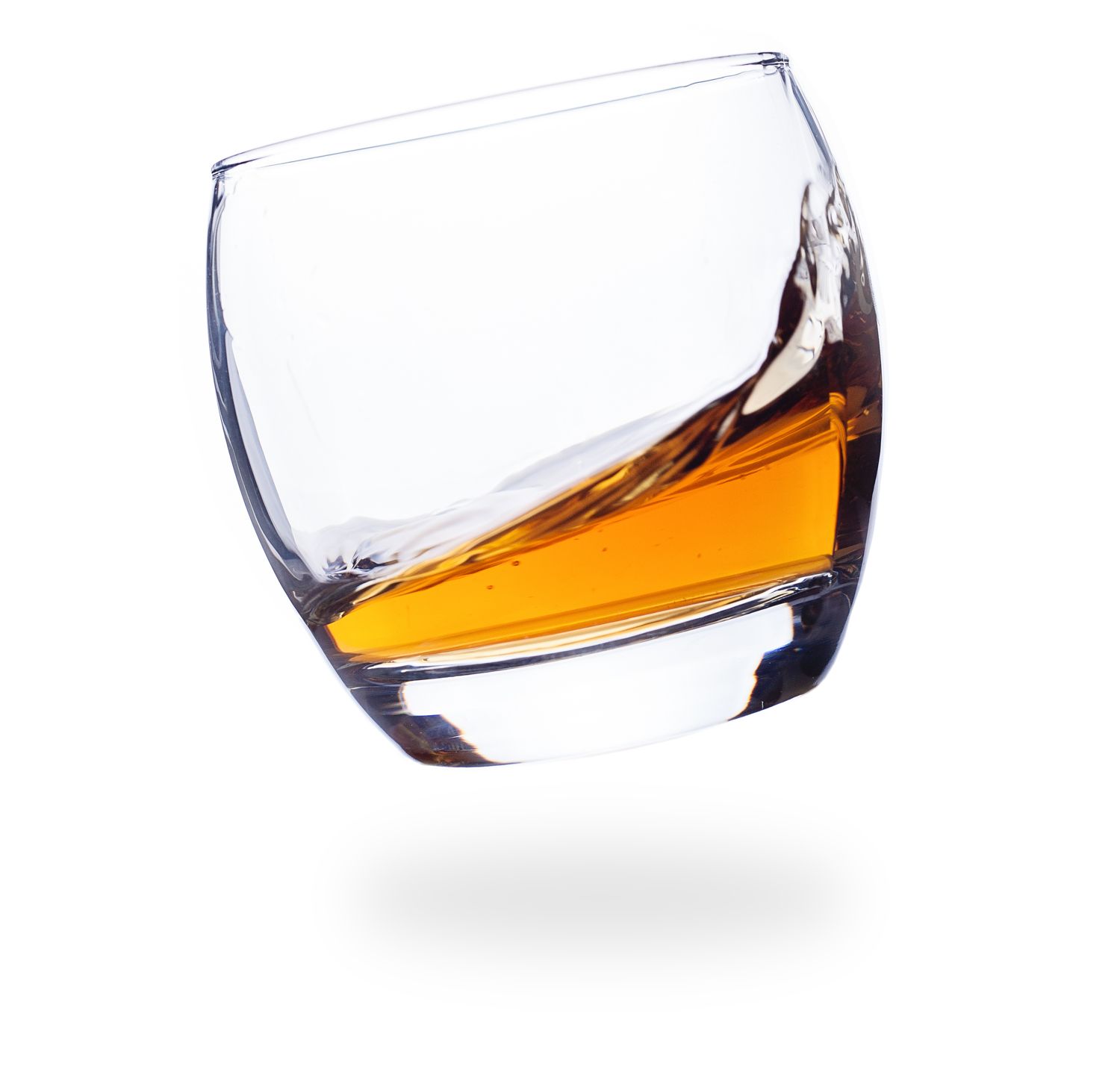
Designer: Michael Stillwell
Photo Editor: Jennifer Newman
From: Town & Country US